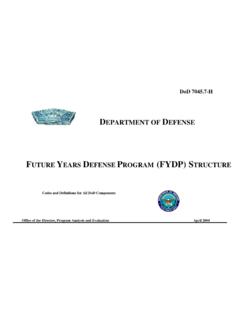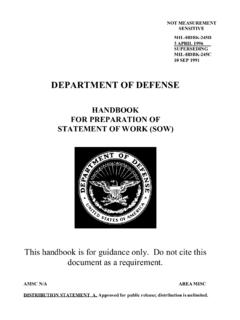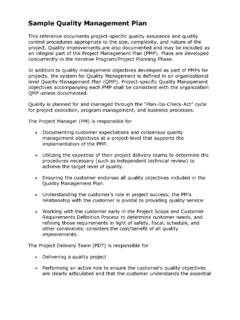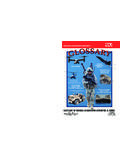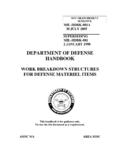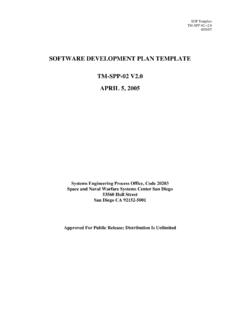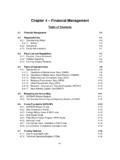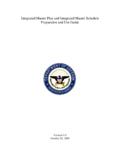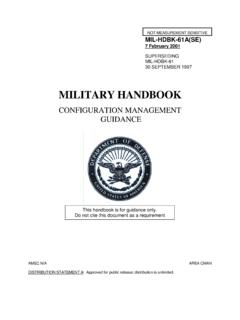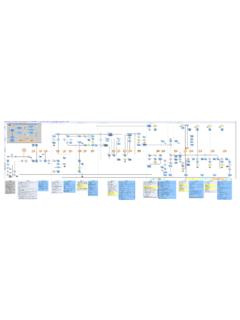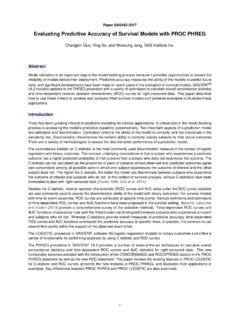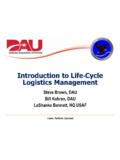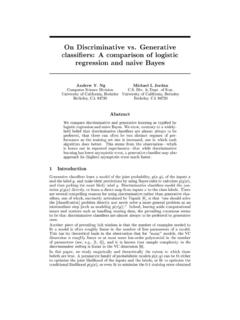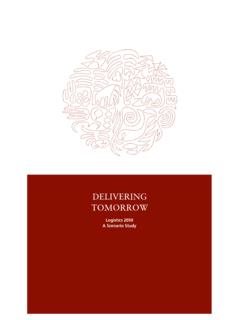Transcription of Integrated Product Support Element Guidebook - AcqNotes
1 1 | Page Integrated Product Support Element Guidebook Update: December 2011 Defense Acquisition University 2 | Page Table of Contents Click button to return to table of contents TABLE OF CONTENTS Foreword Preface 1. Purpose 2. Scope 3. Structure of this Guidebook 4. Using this Guidebook 5. Background 6. Deployment of this Guidebook 7. Disclaimers 1 Product Support Management Objective Description Product Support Manager Activities Product Support Strategies Interim Contractor Support (ICS) Performance Based Life Cycle Product Support (PBL) Transactional Based Hybrid 12 Step Product Support Process Model Integrate Warfighter Requirements & Support Form the Product Support Management IPT Baseline the System Identify / Refine Performance Outcomes Business Case Analysis (BCA) Product Support Value Analysis Determine Support Method(s) Designate Product Support Integrator(s)
2 Identify Product Support Providers Identify / Refine Financial Enablers Establish / Refine Product Support Agreements Implement and Assess Life Cycle Sustainment Plan (LCSP) Statutes, Policy and Guidance Requirements JCIDS Process Defense Acquisition System (DAS) Product Support Business Model (PSBM) PBL Government and Commercial Integrated Community Product Support Arrangements (PSA) of Agreement (MOA) of Understanding (MOU) Level Agreements (SLA) Services Agreements (CSA) 3 | Page Table of Contents Click button to return to table of contents Based Agreements (PBA) Public Private Partnership (PPP) Sales Share Organic / Contractor Hybrid Warranties Product Support Business Model Framework International and Cooperative Programs Assistance Logistics Military Sales (FMS) and International Partners Security Cooperation Agency (DSCA) Traffic in Arms Regulations (ITAR) Department and Case Management Logistic Supply Support Arrangement (CLSSA) Product Support Budgeting and Funding Planning, Programming, Budgeting and Execution (PPBE) Process Working Capital Fund (WCF) Challenges to Product Support Budgeting and Funding Cost Management Better Buying Power / Affordability Total Ownership Cost (TOC) / Life Cycle Cost (LCC) Life Cycle Cost Estimating (LCCE)
3 Contract Development and Management Performance Specifications Request for Proposal (RFP) Contract Deliverables Incentives Earned Value Management System (EVMS) Business Transparency Planning Management Integrated Product and Process Development (IPPD) Integrated Master Schedule (IMS) Integrated Data Environment Decisions, Program Reviews and Independent Assessments Program Decisions Milestone Decisions Exit Criteria Executive Reviews Defense Acquisition Board (DAB) Information Technology Acquisition Board (ITAB) Joint Requirements Oversight Council (JROC) DoD Component Program Technical Reviews Initial Technical Review Alternative Systems Review System Requirements Review 4 | Page Table of Contents Click button to return to table of contents Technology Readiness Assessment Integrated Baseline Review System Functional Review Preliminary Design Review Critical Design Review Test Readiness Review Flight Readiness Review System Verification Review Functional Configuration Audit Production Readiness Review Operational Test Readiness Review Physical Configuration Audit In-Service Review Independent Assessments Independent Cost Estimate Technology Maturity and Technology Readiness Assessment Preliminary Design Review (PDR)
4 Assessment Post-Preliminary Design Review (Post-PDR) Assessment Post-Critical Design Review (Post-CDR) Assessment Logistics Assessment Configuration Management Configuration Identification and Baseline Management Configuration Control Configuration Control Board (CCB) Engineering Change Proposal (ECP) Value Engineering Change Proposal (VECP) Configuration Status Accounting Configuration Verification and Audit Quality Quality in Contracting Quality in Design and Materiel Quality Process Quality Test and Evaluation (T&E) Test and Evaluation Considerations for Product Support Maintainability Demonstration (M-Demo) Logistics Demonstration (Log-Demo) Product Support In Test & Evaluation Master Plan (TEMP) Developmental Test and Evaluation (DT&E) Initial Operational Test and Evaluation (IOT&E) / Operational Test and Evaluation (OT&E)
5 Integrated Developmental Test with Operational Test Prototyping Acceptance Testing Production and Fielding Product Support in Manufacturing Post Production Support Plan 5 | Page Table of Contents Click button to return to table of contents Environmental / Hazardous Waste / Green Issues Deployment / Fielding Sustainment Logistics Implementing Key Performance Parameters and Key System Attributes Product Support Package Services Tailored PBL Checklists and Assessments Continuous Process Improvement Lean Enterprise Six Sigma Theory of Constraints Value Stream Mapping Contingency Logistics Considerations Disposal Disposal Cost Considerations Recycling Transfer to Other Services and Agencies FMS Excess Exchange of Equipment DLA Disposition Services (formerly DRMO) Issues Related to Return and Reintegration Deactivation and Stand Down of Operational Units Demilitarization Munitions Retirement Disposal of Unusable Property Security and Destruction of Classified Items Precious Metal Items Archiving and Record Retention of Historical Data Benefiting Historical Collections End-Use Certificate Other Surplus Property Risk Management Tools and Processes PSM Online Resources Sustainment Maturity Levels (SMLs)
6 Logistics Assessments Enterprise Synergies across IPS elements Business and Variance Analysis DoD Component Tool Resources Product Support Management in the Life Cycle A. Purpose a. Why is Product Support Management Important b. Summary of Activities by Acquisition Phase B. Data item Description (DID) Deliverables C. OSD Proponency, Policy, Regulations and Statutes a. Proponency 6 | Page Table of Contents Click button to return to table of contents b. Policy, Regulations and Statutes D. Who Develops, Delivers and Manages Product Support Management E. When Is Product Support Management Delivered and Managed in the Life Cycle F. How Product Support Management Is Developed, Established and Managed G. Communities of Interest and Practice H.
7 Lessons Learned / Best Practices I. Training Resources J. Key References 2 Design Interface Objective Description Product Support Manager Activities Design for Suitability Reliability Fault Tree Analysis Reliability Block Diagrams Failure Modes and Effects Criticality Analysis (FMECA) Availability Maintainability Design for Affordability Sustainability Modularity and Open System Architecture (MOSA) Interoperability Producibility Testability Transportability Survivability Supportability Human Systems Integration Human Factors Engineering Personnel Aptitudes User Population Description Habitability Manpower Manpower Mix Criteria Manpower Estimate Report Training Environment, Safety, and Occupational Health (ESOH)
8 Environment Safety Occupational Health Key Performance Parameters (KPPs) and Key System Attributes (KSAs) Sustainment KPPs and KSAs Availability 7 | Page Table of Contents Click button to return to table of contents Materiel Availability Operational Availability Reliability Ownership (O&S) Cost Mean Down Time Net-Ready Energy Efficiency Force Protection Standardization Corrosion Prevention Trade Studies Design Interface in the Life Cycle A. Purpose a. Why is Design Interface Important b. Summary of Activities by Acquisition Phase B. Data Item Description (DID) Deliverables C. OSD Proponency, Policy, Regulations and Statutes a. Proponency b. Policy, Regulations and Statutes D. Who Develops, Delivers and Manages Design Interface E.
9 When Is Design Interface Delivered and Managed in the Life Cycle F. How Design Interface Is Developed, Established and Managed G. Communities of Interest and Practice H. Lessons Learned / Best Practices I. Training Resources J. Key References 3 Sustaining Engineering Objective Description Product Support Manager Activities Analysis Operational Profile Analysis Failure Analysis Failure Reporting and Corrective Action System (FRACAS) Trend Analysis Root Cause Analysis Safety Hazard Analysis Mishap Investigation Value Engineering Engineering Technical Services Reliability Growth Diminishing Manufacturing Sources and Material Shortages (DMSMS) Product Improvement Product Improvement Planning Preplanned Product Improvements 8 | Page Table of Contents Click button to return to table of contents Service Life Extension Planning Aging Weapons Systems Management Engineering Dispositions Continuous Modernization Technology Refresh Recapitalization Sustaining Engineering in the Life Cycle A.
10 Purpose a. Why is Sustaining Engineering Important b. Summary of Activities by Acquisition Phase B. Data item Description (DID) Deliverables C. OSD Proponency, Policy, Regulations and Statutes a. Proponency b. Policy, Regulations and Statutes D. Who Develops, Delivers and Manages Sustaining Engineering E. When Is Sustaining Engineering Delivered and Managed in the Life Cycle F. How Sustaining Engineering Is Developed, Established and Managed G. Communities of Interest and Practice H. Lessons Learned / Best Practices I. Training Resources J. Key References 4 Supply Support Objective Description Product Support Manager Activities Supply Chain Management Wholesale versus Retail Classes of Supply Supply Chain Operational Reference Model (SCOR) Joint Supply Chain Architecture (JSCA) Supply Chain Assurance Counterfeit Material Prevention Malicious Hardware and Software Prevention Unauthorized Technology Transfer Prevention Impacts of Environmental Policy Forecasting Market Analysis and Benchmarking Demand Forecasting Readiness Based Sparing (RBS) Availability Based Sparing (ABS)
